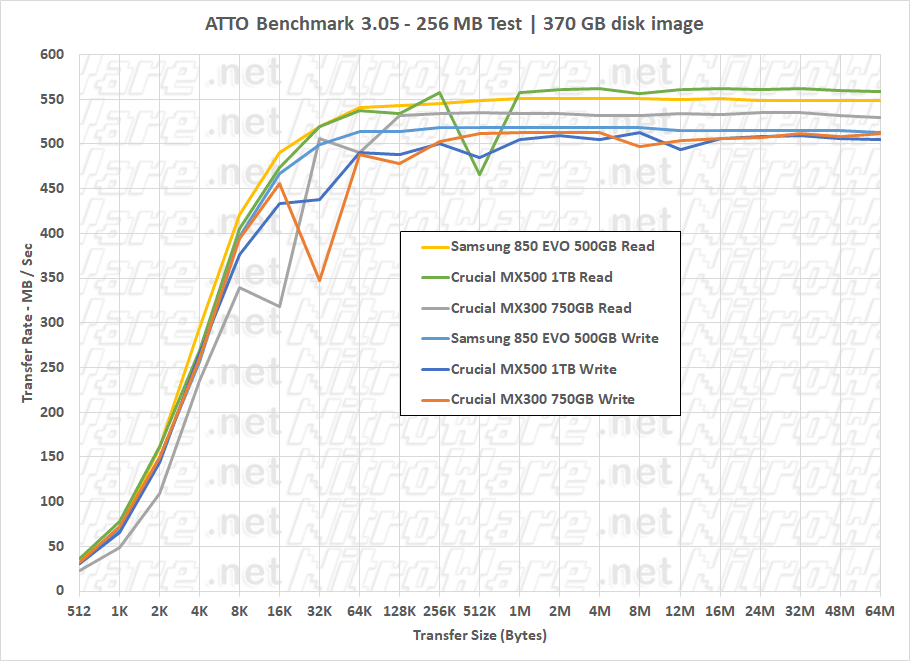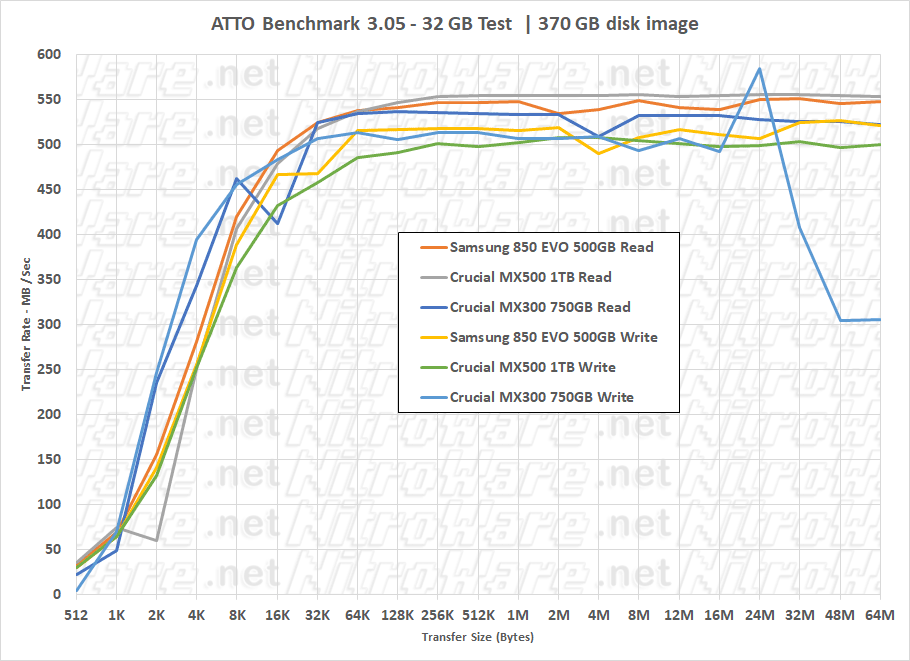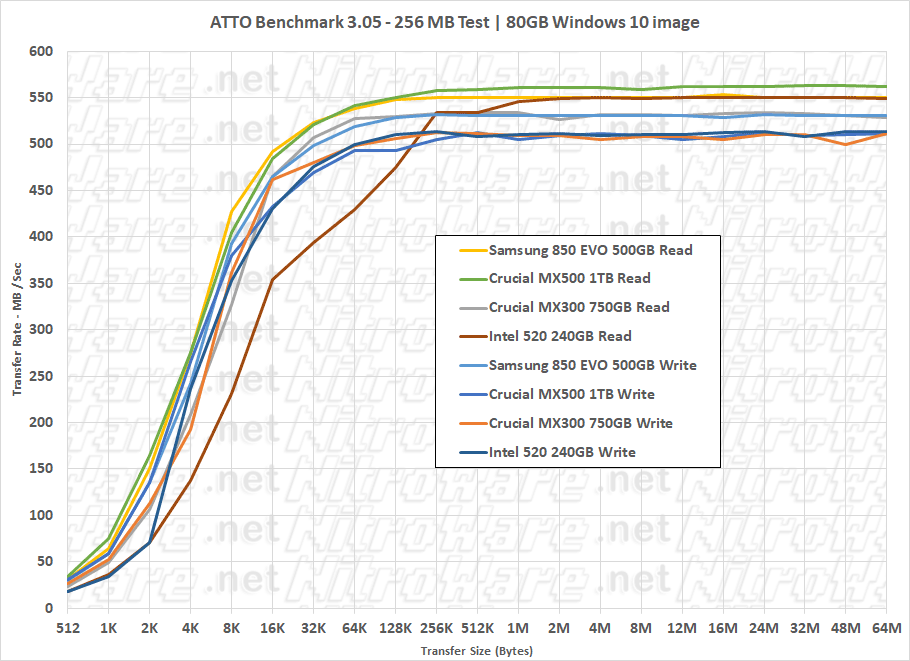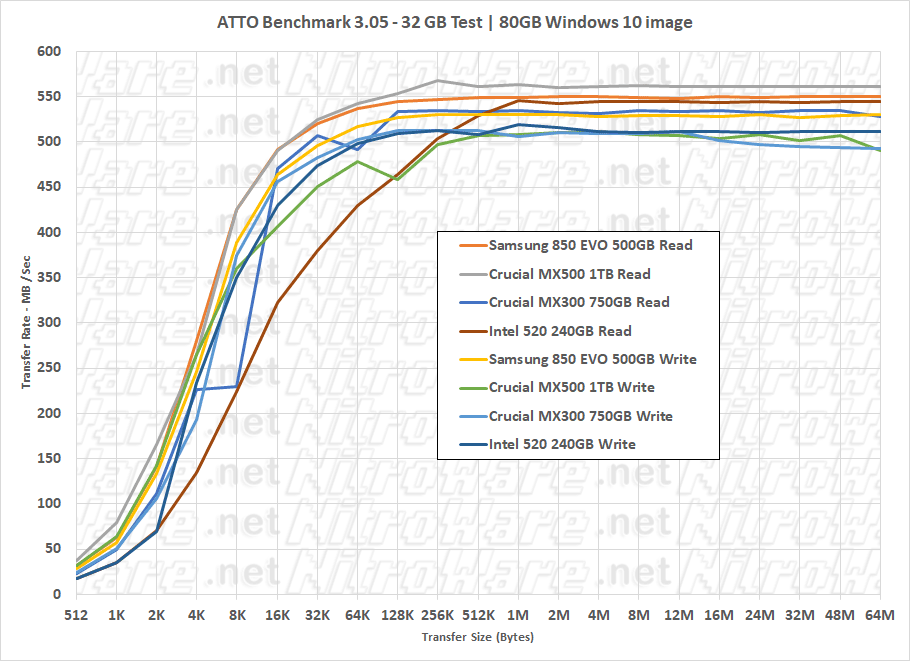Benchmark - ATTO
The default settings for ATTO uses a 256MB file as a test payload, and then reading and writing to that file in blocks between 512 bytes and 64 MegaBytes. Results can and do vary run to run as the test relys on the operating system which itself may decide to run background tasks. For testing purposes there is an override command that can be executed in Windows to immediately run and finish all pending background tasks but even that is not foolproof. For this lets generally ignore any spikes or dips in the ATTO charts, despite having run the tests several times. Different applications use different transfer sizes plus the operating system will queue and coalescence sequential I/Os into large blocks, which gives us the high sequential transfer rates not only speced by the manufacturer but reflected in tests.
Across the range for reads 850 EVO and MX500 were pretty much tied with MX300 trailing. Good. However Having said that over multiple runs I could see some deficencies in the MX300, one way or another i would get signficant blips in the ATTO test curve as illustrated and this is with the same disk image as the other drives.
This is the whole point of including a 'dirty' disk image taken from daily use, to determine the speed and ability of a SSD hardware and firmware platform to shuffle through all its disorganized and fragmented data. Yes, SSDs DO slow down if the drive is fragmented.
Where SSDs struggle in general is writing, and this is why we see the write spec for any SSD always lower than the read spec, especially for NAND Flash based SSDs that store multiple bits per cell such as the TLC 3-bit per cell drives we are testing in this review. Drives based on 3D Cross Point based Flash Memory such as Intel Optane drives access bits directly like DRAM memory and are not as affected by writes.
850 EVO's write curve is as flat as the Nullabor Plain, if we straighten out the Crucial drives they would be similar.
A larger file test in ATTO exposes the affect of write cache in contemporary SSDs, the purpose of which is to speed up reads and write to very high speeds close to the max of the drive. Cache is typically in Gigabytes and can be static or dynamically sized. Reads in this bigger test are generally ok but writes we see strange behavior compared to the smaller 256 MB test with the older MX300. Multiple runs all had the knock-down you can see in the chart that only affects the MX300, noting all three drives in this test use different controllers and Flash memory technology. I suspect that the drive was tuned for better performance at smaller block sizes as seen in the chart at the expense of performance at larger block sizes which are not necessarily a real world reflection on how files are modified on PCs. Also remember the payload under test here, given the speed that the master/source drive was cloned no defragmentation or rearrangement of blocks likely took place.
Setting up a nice and clean Win10 install makes these charts much easier to read ! and since the total size is smaller I could throw in an older drive to see how far things have come. The SandForce controller in the Intel drive was clever for its time using on the fly compression to improve speeds to make up for hardware power. Reads the drive stands out compared to its years newer siblings and writes it can barely match the other drives and this is with Intel's allegedly own tuned firmware that other SanForce drives did not have.
In this plot, we see the drives perform almost as advertised with the drives performing in their 'supposed' order, 850 EVO, MX500, MX300, Intel 520. Samsung just cant be matched here, combining in house flash and controller where as Crucial relies on third party controllers to pair with its Intel-Micron Flash Technologies Joint Venture sourced Flash. The plot curves are relatively smooth and that's what we need.
Again using a larger test file gives us a different impression with more inconsistent pattern behavior especially with the Marvell based Crucial drives but with a light load MX500 still delivers good performance esp for the price.



